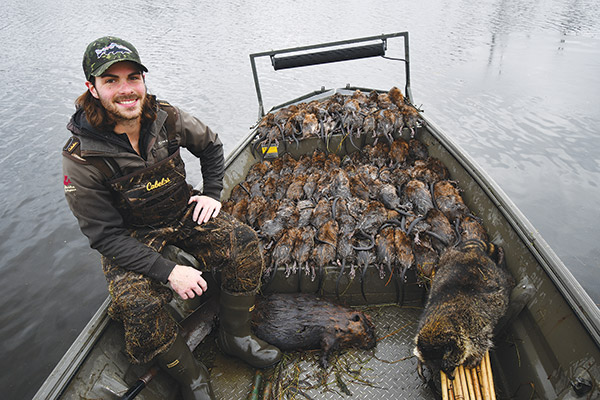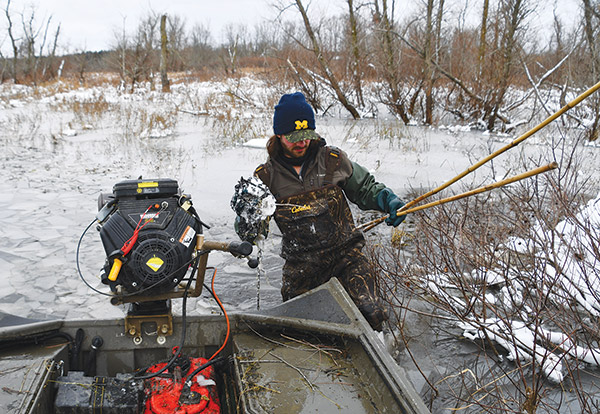 Trapping: Cold Snap Muskrats
Trapping: Cold Snap Muskrats
By Cole DeVault
The TV weatherman called for lows in the 20s with sleet and high winds the week surrounding the early November muskrat opener. “Here we go again,” ran through my head.
Michigan muskrat trappers have faced cold snaps at the beginning of the past several seasons, gazing out across frozen marshes and slush-filled creeks before opening day even arrived.
Knowing flight birds from Canada would surely be swarming the marshes, the temptation to scrap early muskrat trapping in favor of gripping a pump gun was strong. But, being a trapper at heart, I hitched up the mud boat for a scouting run on a nearby slough.
The plastering of huts across the marsh assured me I had made the right call. Once again, I’d be running a line opening morning whether Mother Nature cooperated or not.
Early cold snaps create a variety of challenging conditions. Skim ice that is too thin to walk on can put entire marshes out of reach. The first snows are often wet and slushy, turning the ice opaque and making it difficult to locate dens or bubble trails. Even when the ice gets thick enough to walk on, it may rot later as more seasonable warmer weather returns. All of this demands flexibility from a muskrat trapper who still wants to take advantage of the more abundant fur typically found early in muskrat season.
Tough conditions require a measured approach, and battling through a half-frozen swamp to maintain a few sets may not be the best use of time. Trapping smarter if not necessarily harder is the way to prevent burnout. Being prepared is the other key to success in inclement conditions. Weather forecasts are becoming increasingly accurate, and 10 days before the opener I start keeping tabs on projected overnight lows and potential precipitation. The closer it gets the more accurate the forecasts become, so keep checking right up until the night before.
A thorough understanding of the country you’re working is also essential, and this can only be achieved with a great deal of scouting in the field. A marsh may freeze up after a night or two of below-freezing cold, whereas a drainage ditch down the road may stay open all season. South-facing creek banks and the northern shores of marshes receive more sunlight throughout the day and may remain ice-free. Sloughs that originate from spring seeps frequently stay open despite harsh cold. Being aware of such locations and their “micro climates” can help you come up with an efficient plan.
Generally, I trap public land hot spots early in the season; then I move to private land as the season progresses. But with an early cold-snap, I may stray from this pattern to take advantage of shifting opportunities. If the season opens with slushy marshes and half-frozen ponds on public land, I may turn my attention to ditches and creeks on private land.

While not as productive, these smaller waterways are fed mostly by drain tiles from surrounding crop fields and may remain open well into an early season cold snap. Whether I am waiting for the marshes to freeze solid or to open back up, ditches and creeks keep me busy skinning fur at night.
If public land is all you have, scouting a variety of easy-access locations before the opener can be a wise use of time.
Clusters of huts close to shore and bank dens near the road can be set without long slogs through skim ice—the dreaded kind that is too thick to wade through but too thin to walk on.
“Shin-dinger” ice, I’ve heard it called.
Trap these easier locations early and take the cream of the crop before the competition beats you to it. When conditions improve and the marsh either freezes up or thaws out, you can always go back and set for the rest.
A proactive rat trapper has already marked set locations prior to an early-season freeze. I do this with cheap lath bought in bulk at the lumberyard. It is especially handy for marking runs and the entrances to bank dens and huts. When I find a cloudy run, I just jam a lath into the mud alongside where I want to set the trap. If the location warrants more traps, I put in another lath for each set. I position the lath so the long side aligns with the direction of muskrat travel.
When early ice forms, I wait patiently for the thicker walking-ice. With the run and direction of travel indicated, even if the ice becomes cloudy and bubble-trails disappear it can be as simple as chopping out the lath and then sliding a Conibear or colony trap down into the run.
As I lay out this “lath line,” I keep mental and also written notes on the type of trap each location should get and also the number of traps.
On private marshes and lakes, early season cold snaps can actually be a gift should the ice build without rain or snow falling on it. There is no better opportunity to see bubble trails than in an early layer of clear ice. After marking these private locations, I know I can return later when the rats have primed up and I’ve run out of good public land to trap.
There’s undeniable satisfaction in being able to walk out on a frozen marsh in January, knowing every run and hut entrance is marked and waiting for a trap even if the ice is thick and the snow deep.
But as winter progresses and ice thickens, den entrances and active runs can change and shift. This is especially true in shallow marshes where ice may build all the way down to the mud, effectively pushing muskrats out into deeper water. If a marsh is shallow throughout, don’t wait too long to go back and set the marked locations.
I pre-marked a small marsh early last November when it was humming with rats, planting lath at dozens of obviously active runs. I was confident of success when I returned in December dragging a sled full of Conibears across the ice. Instead, I found hut after hut abandoned, run after run frozen solid. I had waited too long. The thickening ice had either displaced or killed off the rats.

On the other hand, early freeze-ups tend to be followed by thaws. While it’s not a good idea to count on this, being prepared to capitalize on that open water should it come will put more fur in the freezer. And, again, you have to stay flexible to take full advantage of changing conditions.
In the fall, just prior to freeze-up, muskrats go through a flurry of activity in preparation for the coming ice. I have made incredible catches in the days before a first freeze when the rats were building, maintaining, and repairing huts on a nightly basis.
When early cold snaps push this activity up before the opener, I don’t observe the same flurry of activity when the ice thaws back out. Nonetheless, moving in quickly as the ice retreats can still bring big rewards even if the window of opportunity is only a few days before the next cold snap.
As the ice of an early freeze retreats, I focus on large lakes and marshes that are best trapped out of the boat, quickly setting footholds on the huts and feedbeds. Anticipating limited time to run the boat before the water freezes again, I also set extremely heavy.
Done right, the catch can be incredible in newly open water. But not all states allow footholds to be set in this manner, so check first to make sure.
Ideally, I want to get two or three checks at a given location before the traps must be pulled as ice reclaims the marsh. In especially dense pockets of fur, however, setting a line to be checked and pulled the next day is not out of the question, and checking a line twice on the day before a big freeze-up can maximize the catch.
Watch the hourly weather projections closely. Brutal cold snaps tend to happen dramatically, at times changing conditions significantly in as little as a few hours.
If a cold front is forecast to roll through early in the evening, waiting to pull traps until the following morning can be a big mistake. If the front is expected to pass through late in the night, ice accumulation may still be minimal the next morning, and leaving those traps out can add fur to the catch.
This past fall a sizeable slough I trap thawed out for three nights in late November. Up until then, the place had been a slushy mess since the week before the opener. With another cold snap predicted in just three days, I loaded 175 coilsprings in the mud boat and hastily strung out a line. I set the traps especially heavy, three or four for each hut and feedbed. When setting heavy with limited time, I disregard catch percentages and instead focus on the total number of catches. The following morning, my father and I picked up 97 rats. We harvested 65 more the next day.
But then, as predicted, late during night three, the temperature plunged and the slough began turning back to slush. We pulled the line in the morning, busting ice and throwing frozen traps—muskrats, mud and all—into the boat. The weather was deteriorating fast as we approached the last hut with only three more ’rats to make 200 for the weekend. I cut the motor and let the boat grind in through the forming ice.
All three traps held rats, and we hollered in celebration.
That night the entire slough locked tight in an icy grip that didn’t release until the following April.
You don’t have to let early season cold snaps freeze you in your tracks. You may still put fur on the stretchers with a good plan, though sometimes you do have to roll with the punches. Planning ahead, adjusting the approach as needed, and taking advantage of windows of opportunity are the keys to trapping muskrats even when Mother Nature seems to be working against you.

